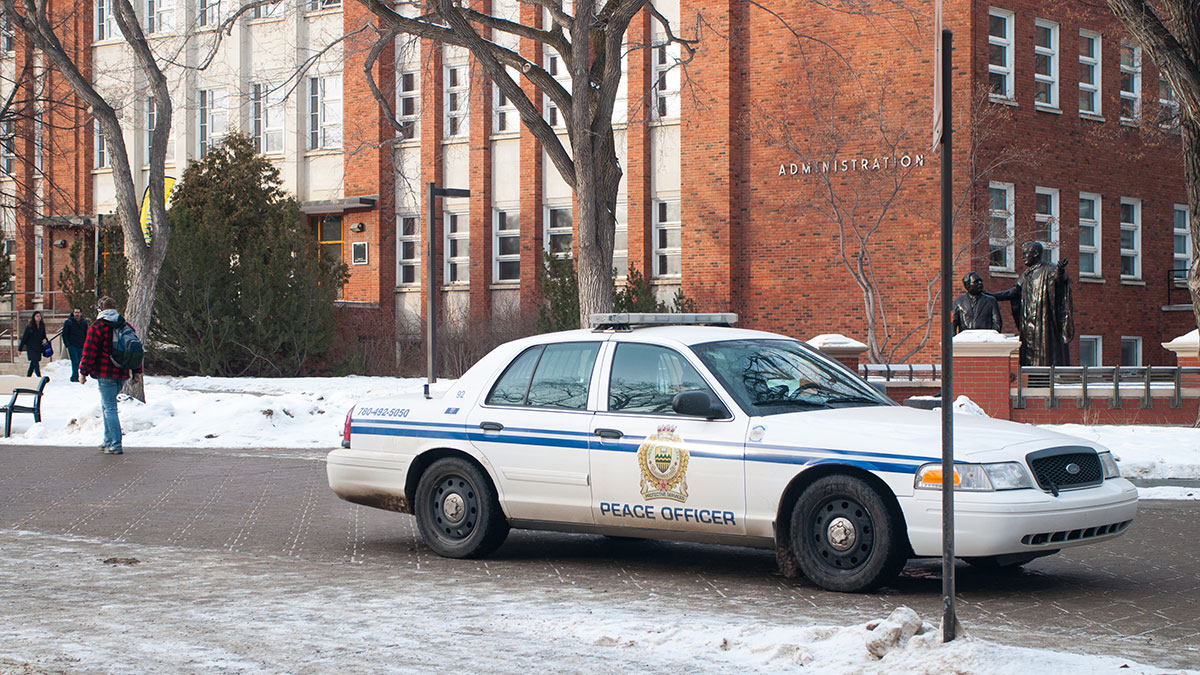U of A develops three-point plan to tackle security concerns, includes staffing and infrastructure
 Christina Varvis
Christina VarvisA new three-part plan, with a budget of $2 million, hopes to address safety and security concerns at the University of Alberta.
James Allen, associate vice-president of operations and maintenance, and Rob Munro, acting associate vice-president of Risk Management Services presented the plan to Students’ Council on January 22. The plans involve an increase in security staffing, an infrastructure plan to upgrade the security features of different buildings, and an education plan to inform students and staff of their role in keeping
Allen and Munro, who are co-chairs of the campus facilities safety and security working group, stressed that all of the parts work together to address these issues.
“It’s not just about increasing the number of protective services,” Allen said. “I do believe this is a comprehensive plan, because either one of these actions taken in isolation will not be effective in curing or in improving our community’s safety and security.”
The “Security Staffing Plan” will add a Community Action Team of two people to patrol high-risk areas such as HUB, SUB, and ECHA, as well as additional security agents who would be stationed in these areas. They are also exploring a partnership with the Edmonton Police Service to have a community liaison-type officer on campus.
After the presentation, native studies councillor Nathan Sunday raised concerns that the increased security presence may make some students uncomfortable.In response, Allen and Munro mentioned there will be an emphasis placed on respectful interactions with the community on the part of security forces.
The “Infrastructure Plan” is currently getting estimates for infrastructure changes to make areas safer through the installation of structures such as access control points and fences that close off at certain times of the day. Some of these changes are set to start in the next few weeks.
Included in this plan is a funding outline for the HUB Mall security improvements. Of the $2 million allocated to implementing the plan, $600,000 will be dedicated to HUB Mall. This follows a push from the HUB Mall Community Association to increase safety in the residence.
A security consultant has been hired to conduct a Crime Prevention Through Environmental Design (CPTED) assessment of HUB Mall, and the process should be finished in early February. Allen said the consultation is to understand the physical infrastructure and the rest of the building.
“To make sure we have a holistic understanding of not just the physical infrastructure improvements, but also the rest of the building,” he said, “Because the building was built for a purpose in the day, and we think those days have evolved and therefore it requires that we evolve and… adapt.”
Allen said they hope to begin implementing the recommendations as soon as possible and that they want to have all of the issues addressed by early August.
The final plan, the ‘Education Plan,’ is intended to help people understand what they can do to help with security, whether it’s reporting suspicious activity, keeping themselves safe or respecting the new infrastructure being put into place. Munro said the education portion is also critical to the overall plan.
“This is not an area we have to spend a lot of money, but we really need to make sure people understand what they can do when they see something occurring, what they can do to keep themselves safe, how they can make sure they’re not defeating infrastructure,” he said.
New plans based on survey data collected last summer
The report, presented by Allen and Munro, found that incidents of robbery, weapons complaints, break and enters, and theft appear to be increasing, as well as that trespassing and suspicious persons make up a significant proportion of service calls. It also showed, based on U of A Protective Services data, that most problems happen on North Campus and around the University and Health Sciences/Jubilee LRT stations.
Some of the recommendations came from a survey done in June 2018 which asked the university community about their perception of security and what specific issues they see. The survey
The main response was that although the campus is safe, their feeling of safety decreases at
The working group consulted with similar institutions across Canada to see how they staff their protective services as well as with social agencies to find out what they’re seeing across the city in terms of homelessness and other issues. They have also been in consultation with different campus groups, such as the SU.
A standing committee will look at data to understand the effectiveness of the measures that will be put in place in 2019, and decide if more measures are needed. There will also be a sub-committee that will include students from the Students’ Union and the student body, that is still being developed.
“We don’t see this as a check in the box, but certainly an ongoing thing to pay attention to,” Allen said.
There are also plans for another survey in March 2019 to get a better idea of how people on campus feel as they get a greater awareness of the measures the university is taking. A second survey is also planned for October/November 2019 to gauge the effectiveness of the measures put into place.
The $2-million budget for these changes is one-time, and so if the projects are successful, the group will seek out additional funding for the 2021 fiscal year to continue the plan.





I’m glad to see there’s finally some action being done, especially focused on the physical environment. Enforcement is not the most effective way to reduce crime and comes with a plethora of issues. Things like better lighting and more community gathering spaces are much more pleasant approaches that bring other beneficial side-effects!